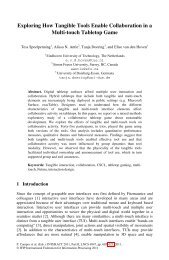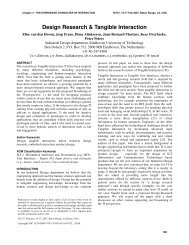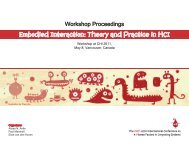Sissy - Elise van den Hoven
Sissy - Elise van den Hoven
Sissy - Elise van den Hoven
You also want an ePaper? Increase the reach of your titles
YUMPU automatically turns print PDFs into web optimized ePapers that Google loves.
Figure 1. Screenshot from Partial Reflections 3, showing the<br />
simulated physical sculpture responding to sounds played on<br />
an acoustic instrument.<br />
Physical modelling techniques have a long history in<br />
sound synthesis (Smith, 2004). Traditionally the<br />
approach has been to create high-fidelity models of the<br />
sound producing mechanisms of real-world musical<br />
instruments in order to produce more realistic synthesised<br />
sounds. One could say that rather than trying to build a<br />
violin sound, the idea is to create a simulated violin. If<br />
the simulation is accurate the sound it produces will be<br />
realistic.<br />
Another, less commonly applied approach, is to use<br />
physical models as a kind of interface layer between the<br />
gestures of the performer and the sounds and/or visuals<br />
produced by the computer. This is the approach used in<br />
the Partial Reflections and Touching Dialogue works.<br />
The primary reason for using physical models as a kind of<br />
intermediate mapping layer between the sounds produced<br />
acoustically by the performer and the computer generated<br />
sounds and visuals was because we were hoping to create<br />
an “instantly knowable, indefinitely masterable interface”<br />
(Levin 2000, p. 56). The musicians who participated in<br />
the design process found that the physical model<br />
interaction paradigm was intuitively understandable and<br />
controllable but provided sufficiently rich and complex<br />
audiovisual responses to allow the discovery and<br />
exploration of new musical-visual material during<br />
performance.<br />
Physical modelling techniques have potential to create<br />
and control sounds that provide a higher degree of<br />
engagement for both performer and audience. Leman<br />
argues that there is evi<strong>den</strong>ce that “listening focuses on the<br />
moving source of a sound rather than on the sound itself”<br />
(Leman, 2007 p.236). In other words, when we hear<br />
music, we perceive it in terms of physical actions that we<br />
associate with such sounds. These need not necessarily<br />
be the physical actions that actually cause the sounds, but<br />
actions that we somehow associate with them based on<br />
past experiences.<br />
He proposes a model of musical communication based on<br />
the encoding and decoding of biomechanical energy in<br />
sound. In this model, the performer realises musical<br />
goals by physically manipulating an instrument, which<br />
translates the performer's physical energy into sound.<br />
14<br />
The listener, at least partially through a process of<br />
associating sounds with physical actions, makes sense of<br />
the sound. This is not to say that the listener's<br />
understanding of the music will be i<strong>den</strong>tical to that of the<br />
performer's, but rather that the listener will make sense of<br />
the sound in their own action-related terms. The<br />
implication is that instruments, which facilitate a more<br />
direct connection between the physical actions of<br />
performers and generated sounds, are more likely to<br />
facilitate musical communication at this gestural level.<br />
Modes of Interaction<br />
During 2007 and 2008 a series of user studies examining<br />
musicians’ experiences with the Partial Reflections sound<br />
sculptures were conducted (Johnston et al, 2008,<br />
Johnston, 2009). The key issue that arose was that of<br />
modes of interaction.<br />
It was observed that the musicians’ interactions with the<br />
virtual instruments could be classified into three modes:<br />
instrumental, ornamental and conversational.<br />
When approaching a virtual instrument ‘instrumentally’,<br />
musicians sought detailed control over all aspects of its<br />
operation. They wanted the response of the virtual<br />
instrument to be consistent and reliable so that they could<br />
guarantee that they could produce particular musical<br />
effects on demand. When interacting in this mode,<br />
musicians seemed to see the virtual instruments as<br />
extensions of their acoustic instruments. For these<br />
extensions to be effective, the link between acoustic and<br />
virtual instruments had to be clear and consistent.<br />
When musicians used a virtual instrument as an<br />
‘ornament’, they surrendered detailed control of the<br />
generated sound and visuals to the computer, allowing it<br />
to create audio-visual layers or effects that were added to<br />
their sound. A characteristic of ornamental mode is that<br />
the musicians did not actively seek to alter the behaviour<br />
or sound of the virtual instrument. Rather, they expected<br />
that it would do something that complemented or<br />
augmented their sound without requiring direction from<br />
them.<br />
While it was not always the case, it was observed that the<br />
ornamental mode of interaction was sometimes a fallback<br />
position when instrumental and conversational<br />
modes were unsuccessful. While some musicians were<br />
happy to sit back and allow the virtual instrument to<br />
provide a kind of background ‘audiovisual wallpaper’ that<br />
they could play counterpoint to, others found this<br />
frustrating, ending up in an ornamental mode of<br />
interaction only because their attempts at controlling or<br />
conversing with the virtual instrument failed.<br />
In the conversational mode of interaction, musicians<br />
engaged in a kind of musical conversation with the virtual<br />
instrument as if it were another musician. This mode is in<br />
a sense a state where the musician rapidly shifts between<br />
instrumental and ornamental modes, seizing the initiative<br />
for a time to steer the conversation in a particular<br />
direction, then relinquishing control and allowing the<br />
virtual instrument to talk back and alter the musical<br />
trajectory in its own way. Thus each of the three modes of



![Download 1.8 MB [pdf] - Elise van den Hoven](https://img.yumpu.com/18078175/1/190x245/download-18-mb-pdf-elise-van-den-hoven.jpg?quality=85)

![Download 0.2 MB [pdf] - Elise van den Hoven](https://img.yumpu.com/18078145/1/182x260/download-02-mb-pdf-elise-van-den-hoven.jpg?quality=85)
![Download 0.1 MB [pdf] - Elise van den Hoven](https://img.yumpu.com/18078125/1/190x146/download-01-mb-pdf-elise-van-den-hoven.jpg?quality=85)
![Download 1.9 MB [pdf] - Elise van den Hoven](https://img.yumpu.com/18078041/1/182x260/download-19-mb-pdf-elise-van-den-hoven.jpg?quality=85)

